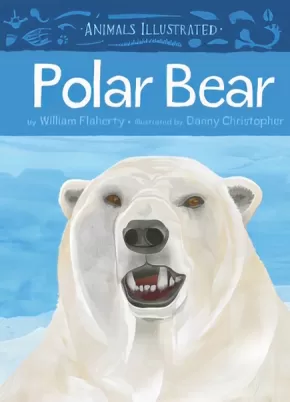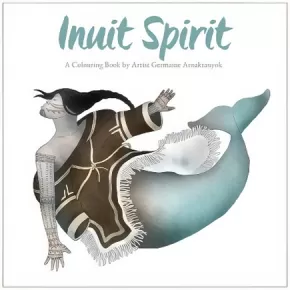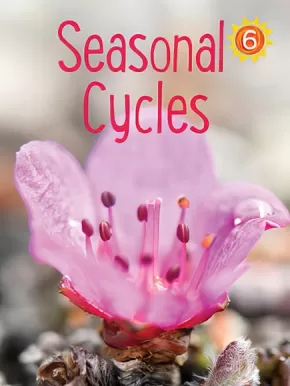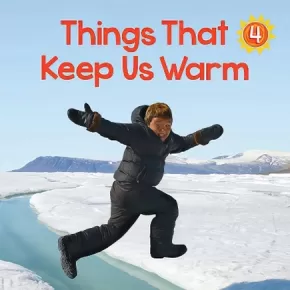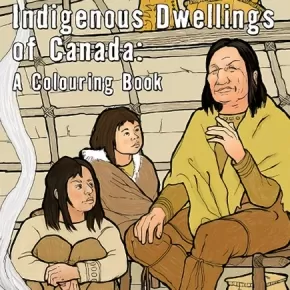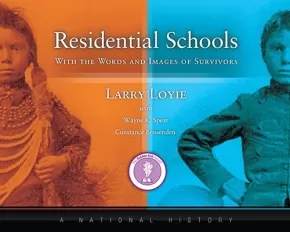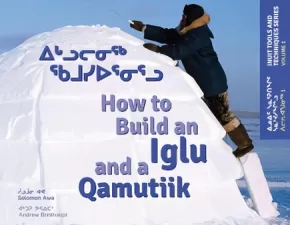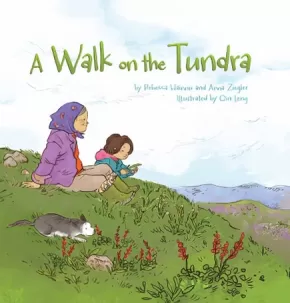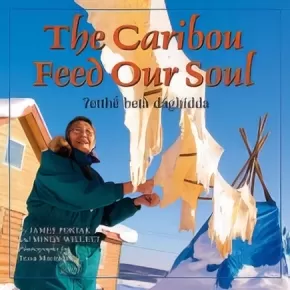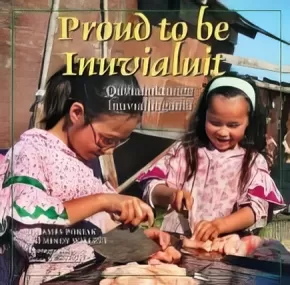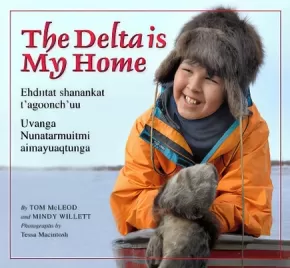
Inuit
76
-
90
of
92 Results;
Sort By
Go To
of 7
Animals Illustrated: Muskox
$15.95
Artists:
Format:
Hardcover
Text Content Territories:
Indigenous Canadian; Inuit;
ISBN / Barcode: 9781772271225
Synopsis:
Synopsis:
Animals Illustrated mixes fun-filled animal facts suitable for the youngest of readers with intricately detailed illustrations to create a unique and beautiful collection of children's non-fiction nooks on Arctic animals. Each volume contains first-hand accounts from authors who live in the Arctic, along with interesting facts on the behaviours and biology of each animal.
Kids will learn how Muskoxen raise their babies, what they eat and how they forage, where they can be found, and other interesting information, like the many fascinating adaptations they exhibit that allow them to live in colder habitats than most other animals!
Awards
- 2017 Canadian Children's Book Centre Best Books for Kids and Teens
Reviews
“Design of the series is spot-on, with attractive covers and lay-out that is both consistent throughout the series and age-appropriate for conveying information visually and textually.” — Kid Lit North
“. . . [I]ncludes extensive information about the muskoxen’s strategies for defense and for withstanding the cold.” — CanLit for Little Canadians
“The author, a Nunavut hunter and trapper, knows the animal well and shares his knowledge.” — Sal’s Fiction Addiction
Educator & Series Information
This book is part of the non-fiction Animals Illustrated series, which mixes fun-filled animal facts suitable for the youngest of readers with intricately detailed illustrations to create a unique and beautiful collection of children’s non-fiction books on Arctic animals. Each volume contains firsthand accounts from authors who live in the Arctic, along with interesting facts on the behaviours and biology of each animal.
Recommended Ages: 5-7
Available in French: Bœuf musqué
Additional Information
24 pages | 6.75" x 9.25"
Animals Illustrated: Narwhal (3 in Stock, in Reprint)
$15.95
Artists:
● Hwei Lim
Format:
Hardcover
Text Content Territories:
Indigenous Canadian; Inuit;
ISBN / Barcode: 9781772270808
Synopsis:
Synopsis:
Animals Illustrated mixes fun-filled animal facts suitable for the youngest of readers with intricately detailed illustrations to create a unique and beautiful collection of children's non-fiction books on Arctic animals. Each volume contains first-hand accounts from authors who live in the Arctic, along with interesting facts on the behaviours and biology of each animal.
Kids will learn about how narwhal raise their young in the cold Arctic ocean, what they eat, and where they can be found, along with other interested information, like the fact that a narwhals long tusk is actually a tooth!
Reviews
“Narwhal is definitely recommended for school libraries and classroom collections.” — CM Magazine
“The table of contents gives a clear sense of organization. The illustrations are both scientifically accurate, engaging, and beautiful.” — Kid Lit North
“. . . [I]ncludes comment about the narwhal’s deep diving and behaviour beneath the ice, as well as about its impressive tooth, often referred to as a tusk, that can grow up to almost 3 metres in length.” — CanLit for Little Canadians
Educator & Series Information
This book is part of the non-fiction Animals Illustrated series, which mixes fun-filled animal facts suitable for the youngest of readers with intricately detailed illustrations to create a unique and beautiful collection of children’s non-fiction books on Arctic animals. Each volume contains firsthand accounts from authors who live in the Arctic, along with interesting facts on the behaviours and biology of each animal.
Recommended Ages: 5-7
This book is available in French: Narval
Additional Information
24 pages | 6.75" x 9.25"
Animals Illustrated: Polar Bear
$15.95
Artists:
Format:
Hardcover
Text Content Territories:
Indigenous Canadian; Inuit;
ISBN / Barcode: 9781772270792
Synopsis:
Synopsis:
Animals Illustrated mixes fun—filled animal facts suitable for the youngest of readers with intricately detailed illustrations to create a unique and beautiful collection of children's non—fiction books on Arctic animals. Each volume contains first—hand accounts from authors who live in the Arctic, along with interesting facts on the behaviours and biology of each animal.
Kids will learn how polar bears raise their babies, what they eat and how they hunt, where they can be found, and other interesting information, like the fact that polar bears actually have transparent fur and black skin!
Awards
- 2017 Canadian Children's Book Centre Best Books for Kids and Teens
Reviews
“The polar bear is presented to the audience in a respectful way.” — CM Magazine
“Design of the series is spot-on, with attractive covers and lay-out that is both consistent throughout the series and age-appropriate for conveying information visually and textually.” — Kid Lit North
“Animals Illustrated is a significant series for young animal lovers . . .” — CanLit for Little Canadians
Educator & Series Information
This book is part of the non-fiction Animals Illustrated series, which mixes fun-filled animal facts suitable for the youngest of readers with intricately detailed illustrations to create a unique and beautiful collection of children’s non-fiction books on Arctic animals. Each volume contains firsthand accounts from authors who live in the Arctic, along with interesting facts on the behaviours and biology of each animal.
Recommended Ages: 5-7
This book is available in French: Ours polaire
Additional Information
24 pages | 6.70" x 9.25"
Inuit Spirit
$14.95
Artists:
Format:
Paperback
Text Content Territories:
Indigenous Canadian; Inuit;
ISBN / Barcode: 9781772271263
Synopsis:
Synopsis:
This colouring book features dozens of line drawings by renowned Inuit artist Germaine Arnaktauyok, followed by information on Germaine's own artistic process and her unique drawing style inspired by pointillism. Perfect for art lovers and avid colouring fans alike.
Additional Information
58 pages | 10.00" x 8.50"
Seasonal Cycles - Nunavummi Reading Series
$8.95
Format:
Paperback
Text Content Territories:
Indigenous Canadian; Inuit;
Grade Levels: 1;
ISBN / Barcode: 9781772660777
Synopsis:
Synopsis:
What do the different seasons look like in the North?
This book supports early science learning by teaching children about the seasonal changes that take place throughout the year in the Arctic.
Educator Information
This book is part of the Nunavummi Reading Series, a Nunavut-developed series that supports literacy learning while teaching readers about the people, traditions, and environment of the Canadian Arctic. Seasonal Changes is a Level 6 book in the series.
Nunavummi Reading Series books have also been officially levelled using the Fountas & Pinnell Text Level Gradient™ Levelling System. Seasonal Change's F&P Level is E.
Recommended for ages 4-6.
This book teaches about the five seasons in Nunavut. The Inuit have more seasons than just summer, spring, winter, and fall.
Additional Information
12 pages | 6.00" x 8.00" | Full-colour photographs throughout
Structures in the Arctic - Nunavummi Reading Series
$6.95
Format:
Paperback
Text Content Territories:
Indigenous Canadian; Inuit;
Grade Levels: 1;
ISBN / Barcode: 9781772660852
Synopsis:
Synopsis:
Learn about the different structures you can see every day in the North!
This non-fiction book introduces children to the features of manmade structures commonly seen in the North, like igloos and inukshuks, and structures familiar throughout Canada, like airports and houses.
Educator Information
This book is part of the Nunavummi Reading Series, a Nunavut-developed series that supports literacy learning while teaching readers about the people, traditions, and environment of the Canadian Arctic. Structures in the Arctic is a Level 7 book in the series.
Nunavummi Reading Series books have also been officially levelled using the Fountas & Pinnell Text Level Gradient™ Levelling System. Structures in the Arctic's F&P Level is I.
Recommended for ages 4-6.
Additional Information
16 pages | 8.00" x 8.00"
Things That Keep Us Warm - Nunavummi Reading Series
$6.95
Format:
Paperback
Text Content Territories:
Indigenous Canadian; Inuit;
Grade Levels: Kindergarten;
ISBN / Barcode: 9781772660555
Synopsis:
Synopsis:
Learn how people stay warm during the long Arctic winters.
This book uses simple sentences to describe items common throughout Canada, like the parka, and some items that are uniquely Northern, like the qulliq (oil lamp).
Educator Information
This book is part of the Nunavummi Reading Series, a Nunavut-developed series that supports literacy learning while teaching readers about the people, traditions, and environment of the Canadian Arctic. Things That Keep Us Warm is a Level 4 book in the series.
Nunavummi Reading Series books have also been officially levelled using the Fountas & Pinnell Text Level Gradient™ Levelling System. Things That Keep Us Warm's F&P Level is B.
Recommended for ages 3-5.
This resource is also available in French: Les choses qui nous tiennent au chaud
Additional Information
8 pages | 7.00" x 7.00" | Full-colour photographs throughout
Indigenous Dwellings of Canada: A Colouring Book
$6.95
Artists:
Format:
Paperback
Text Content Territories:
Indigenous Canadian;
Synopsis:
Get ready to have fun and learn at the same time! Explore the many different homes and cultures of Turtle Island’s nations, past and present, throughout Indigenous Dwellings of Canada.
Each beautiful, black-line illustration includes carefully researched commentaries by Katherine and Leo Pettipas. Not only do they tell fun stories, but offer informative glimpses into Canadian history.
This educational colouring book is full of images and tales that will delight students and artists of all ages.
Residential Schools, With the Words and Images of Survivors
$34.95
Format:
Hardcover
Text Content Territories:
Indigenous Canadian;
ISBN / Barcode: 9780993937101
Synopsis:
Synopsis:
Residential Schools, With the Words and Images of Survivors, A National History honours the survivors, the former students, who attended residential schools. Designed for the general reader this accessible, 112-page history offers a first-person perspective of the residential school system in Canada, as it shares the memories of more than 70 survivors from across Canada as well as 125 archival and contemporary images (65 black & white photographs, 51 colour, some never before published).
This essential volume written by award-winning author Larry Loyie (Cree), a survivor of St. Bernard Mission residential school in Grouard, AB, and co-authored by Constance Brissenden and Wayne K. Spear (Mohawk), reflects the ongoing commitment of this team to express the truths about residential school experiences and to honour the survivors whose voices are shared in this book.
Along with the voices, readers will be engaged by the evocative, archival photographs provided by the Shingwauk Residential Schools Centre with the assistance of curator Krista McCracken. The book begins with the moving introduction by Larry Loyie, and moves to seven chapters that explore the purpose of this school system; cultures and traditions; leaving home; life at school the half-day system; the dark side of the schools; friendship and laughter coping with a new life; changing world–the healing begins; and an afterword. A detailed, full colour map showing residential schools, timeline with key dates, glossary, and a helpful index (including names of survivors and schools) make this vital resource a must-have for secondary, college, and universities, libraries, and the general reader.
Reviews
"A broad and comprehensive review of the history of First Nations, Métis, and Inuit peoples in Canada told from the perspective of First Peoples in a very accessible way. Any educator, regardless of personal background or heritage, would find this timely resource very useful in any classroom." — Gary Fenn and Domenic Bellissimo, executive assistants, Ontario Secondary School Teachers’ Federation
"Written with a gentle hand, this book describes a history that few Canadians understand or even know about. From the first page, those in search of the truth are engaged in a journey of learning, as they come to understand the true battle of Aboriginal peoples to preserve their cultures and pride. This story is a true account of resiliency and human spirit." — Tracy Zweifel, executive director, Sagitawa Friendship Society, Alberta
Awards
- 2016 Winner of Golden Oak award in Ontario's Forest of Reading program
Educator Information
This must-have resource includes a detailed, full-colour map showing residential schools, a timeline with key dates, and a glossary.
Recommended for grades 7-12, but would still be useful for adults and college/university courses studying residential schools and Indigenous history.
This book has been evaluated and approved by ERAC (Educational Resource Acquisition Consortium, British Columbia).
Additional Information
112 pages | 10.43" x 8.26"
How to Build an Iglu and a Qamutiik: Inuit Tools and Techniques, Volume One
$12.95
Artists:
Format:
Paperback
Text Content Territories:
Indigenous Canadian; Inuit;
ISBN / Barcode: 9781927095317
Synopsis:
Synopsis:
The iglu, a traditional winter shelter built in the Arctic for centuries, is a vital part of Inuit culture. The qamutiik, a traditional sled used for hunting, is an essential tool whose versatility and dependability have allowed it to endure over time.
In How to Build an Iglu & a Qamutiik, Solomon Awa provides thorough how-to instructions on building iglus and qamutiiks, along with general background information on their construction and importance to survival. Complete with detailed, clear illustrations, this valuable resource will teach readers to build these structures that are so central to Inuit culture and tradition.
Educator Information
Delivered in a dual-language format of English and Ikutitut.
Additional Information
32 pages | 9.00" x 7.00" | b&w illustrations, colour photographs
A Stranger at Home: A True Story
$12.95
Editors:
Format:
Paperback
Text Content Territories:
Indigenous Canadian; Inuit; Inuvialuit (Mackenzie Inuit);
ISBN / Barcode: 9781554513611
Synopsis:
Synopsis:
The powerful memoir of an Inuvialuit girl searching for her true self when she returns from residential school.
Traveling to be reunited with her family in the Arctic, 10-year-old Margaret Pokiak can hardly contain her excitement. It's been two years since her parents delivered her to the school run by the dark-cloaked nuns and brothers.
Coming ashore, Margaret spots her family, but her mother barely recognizes her, screaming, "Not my girl." Margaret realizes she is now marked as an outsider.
And Margaret is an outsider: she has forgotten the language and stories of her people, and she can't even stomach the food her mother prepares.
However, Margaret gradually relearns her language and her family's way of living. Along the way, she discovers how important it is to remain true to the ways of her people -- and to herself.
Highlighted by archival photos and striking artwork, this first-person account of a young girl's struggle to find her place will inspire young readers to ask what it means to belong.
Sequel to Fatty Legs.
Reviews
"This memoir, detailing a woeful piece of Canadian history and demonstrating Margaret's strength of character, compassion, courage and her willingness to sacrifice herself for her family's sake, gives the reader a lot to ponder. Highly recommended." — Shelbey Krahn, Canadian Materials, February 2012
"A Stranger at Home will speak to anyone who has experienced displacement or assimilation into a new culture. This fabulous story enhances the Grades 6 to 8 social studies curriculum." — Professionally Speaking (Ontario College of Teache, April 2012
"While it may not have the same drama and tension of the first memoir, this tale provides a compelling and moving story of a girl searching for the strength to find her place in the world." — Jody Kopple, School Library Journal, December 2011
"Without being graphic or overwhelming, the Fentons recreate a tragic moment in Canadian history through the innocent reflections of a child...a must for any classroom library." — Canadian Teacher Magazine, May 2012
"This tale provides a compelling and moving story of a girl searching for the strength to find her place in the world. The writing is unpretentious and accessible and readers who enjoyed the first book will find this an interesting follow-up. Vivid paintings are a beautiful accompaniment to the storytelling. Photographs from Pokiak Fenton's own collection add important points of reference for readers looking to visualize the characters and the unique setting of the Arctic Circle. A welcome addition to biography collections." — Jody Kopple, School Library Journal, December 2011
Educator Information
Recommended Ages: 9-13.
Guided Reading Level: Fountas and Pinnell U
Themes: biography; Inuit; Indigenous peoples; arctic; residential schools; identity; community; Canadian content; family; society; history; memoir.
This resource is also available in French: Étrangère chez moi
Additional Information
128 pages | 6.25" x 9.00"
A Walk on the Tundra
$13.95
Artists:
● Qin Leng
Format:
Paperback
Text Content Territories:
Indigenous Canadian; Inuit;
ISBN / Barcode: 9781772271850
Synopsis:
Synopsis:
A Walk on the Tundra follows Inuujaq, a little girl who travels with her grandmother onto the tundra. There, Inuujaq learns that these tough little plants are much more important to Inuit than she originally believed.
In addition to an informative storyline that teaches the importance of Arctic plants, this book includes a field guide with photographs and scientific information about a wide array of plants found throughout the Arctic.
Reviews
This volume is a cross between a picture book, a story and a field guide to edible plants.... Authors, Rebecca Hainnu and Anna Ziegler, have worked on several educational publications. That background is apparent in this book. There are eighteen Inuktitut words, including 6 plant names, introduced in the text. They are explained and italicized when they are first introduced, for example “Nirilikkit – eat them”. The next time the word is used, it is assumed that the reader knows what it means.... [A]s a tool for building vocabulary, or as a storybook for students who have some familiarity with Inuktitut, this work would be excellent." – Sandy Campbell, The Deakin Review of Children’s Literature
Additional Information
40 pages | 8.50" x 8.50"
The Caribou Feed Our Soul
$19.95
Artists:
Format:
Hardcover
Text Content Territories:
Indigenous Canadian; First Nations; Dene; Denesuline (Chipewyan);
ISBN / Barcode: 9781897252673
Synopsis:
Synopsis:
Pete Enzoe is Chipewyan Dene from Lutsel K’e, Northwest Territories, on the East Arm of Great Slave Lake. He is a hunter, fisher, and trapper. He sees his role in life as protector of the caribou and spends much of his time “reading” the land as he travels his peoples’ traditional areas. Pete also helps scientists to monitor the herd’s health and migration. In The Caribou Feed Our Soul, the sixth book in The Land is Our Storybook series, Pete takes readers on a respectful caribou harvest. Along the way, he shares creation stories about how his people are descendants of the caribou. He also describes the spiritual areas his community is trying to protect, including Thaidene Nene, which means “land of our ancestors.” Pete’s stories help the reader to understand the rich history of the Chipewyan Dene and their relationship with the caribou today.
Educator & Series Information
This is the sixth book in the "The Land Is Our Storybook" series, which considers the diverse lands and cultures of Canada's Northwest Territories. Told in a uniquely diverse range of northern voices, with a child-centred approach, books in the series highlight each official Aboriginal language group in the NWT, revealing a richly textured picture of life in the North-on the trapline, around the campfire, in communities, at school, and within the outdoor school that is the land itself. The series celebrates the seasons, ages, genders, traditional activities, and communities of the NWT.
The stories are illustrated by the striking images of acclaimed northern photographer, Tessa Macintosh and depict the similarities in lifestyle between children of the North and South, as well as the marked cultural differences, and highlight the special relationship these First Nations people have with the land and how they are adapting to rapid change while remaining connected to the land. Images of the landscape and animals within it, of trapping, hunting, fishing, and bannock baking sit alongside pictures of children at school, swimming at recreation centres, and reading in libraries. Here is modern northern culture painted beautifully: a complex mix of the new and the old.
These wonderful books, written with a variety of provincial and territorial curricula in mind, are specially designed for the classroom and include special features such as glossaries relating details on animals biology and cultural definitions, regional and language maps. The text of the stories also have sidebars such as Our Stories, which contain the stories of the people and language group featured, and Our Words, which highlight words in the featured language that are important to the story.
Recommended Grade Level: 2-7
Additional Information
|
Proud to Be Inuvialuit: Quviahuktunga Inuvialuugama
$19.95
Artists:
Format:
Hardcover
Text Content Territories:
Indigenous Canadian; Inuit; Inuvialuit (Mackenzie Inuit);
ISBN / Barcode: 9781897252598
Synopsis:
Synopsis:
James Pokiak is proud to be Inuvialuit, which means "real people."
The Inuvialuit are the most westerly Canadian Inuit. James lives in the hamlet of Tuktoyuktuk, NWT, which is above the Arctic Circle on the shore of the Arctic Ocean. The community is often just called Tuk to save time. Even though he lives in town now, James grew up on the land, learning the traditional values and survival skills of his people.
In this book, the fifth in the The Land is Our Storybook series, James and his daughter, Rebecca, go on a trip to harvest beluga whale. Harvesting and preparing beluga meat together as a family is an integral part of what it means to be Inuvialuit. Join James and Rebecca and learn about how the beluga whale is interlinked with Inuvialuit culture and history.
Educator & Series Information
Recommended Ages: 8-12
This is the fifth book in the The Land Is Our Storybook Series, a first-ever series of books for children about the diverse lands and cultures of Canada's Northwest Territories.
Additional Information
32 pages | 8.33" x 8.25"
The Delta Is My Home
$16.95
Format:
Hardcover
Text Content Territories:
Indigenous Canadian; Inuit; Inuvialuit (Mackenzie Inuit); First Nations; Dene; Dinjii Zhuh (Gwich'in);
ISBN / Barcode: 9781897252321
Synopsis:
Synopsis:
Tom McLeod is an eleven-year-old boy from Aklavik who is a gifted storyteller heard frequently on CBC Radio North. He is of mixed cultural heritage-Gwich'in and Inuvialuit.
Tom tells us why his home in the Mackenzie Delta is a special place and why he loves to live on the land. He describes how his town floods in the spring and why he loves "ratting" (trapping muskrats) and hunting "black ducks" (white-winged and surf scoters) in the Delta. Readers will learn why these ducks are decreasing in number and how and why they are important to Tom and his people.
Tom says, "Northerners have always hunted animals for survival. We are careful about how we use the land. To be good hunters we need to pay attention to what is happening on the land around us-that's why it's important for us to be out there. We are the first to know if the land and animals are changing."
Reviews
"The Delta is My Home, is presented in way children will take pleasure in reading. They will be enthralled with the photographs and in the end they will learn a great deal about the culture, family and life of Tom McLeod and the Gwich'in people." — ForeWord Magazine
"...a valuable introduction to an endangered culture." — Booklist
"Tom's bouncingly fun personality beams from every page. . . This is an exciting series for helping children, especially those outside the Northwest Territories, appreciate the day-to-day world of their peers." — Canadian Children's Book News
"[The Delta Is My Home] feature[s] a satisfying mix of old and new - traditional and contemporary - in the photographs and text. . . What both photos and text do very well is establish the strong connection between the people in the books and the land upon which they live. . . A book that children [will] choose to read both for pleasure and for information. — CM Magazine
Educator & Series Information
This book is part of the "The Land Is Our Storybook" series, which considers the diverse lands and cultures of Canada's Northwest Territories. Told in a uniquely diverse range of northern voices, with a child-centred approach, books in the series highlight each official Aboriginal language group in the NWT, revealing a richly textured picture of life in the North-on the trapline, around the campfire, in communities, at school, and within the outdoor school that is the land itself. The series celebrates the seasons, ages, genders, traditional activities, and communities of the NWT.
The stories are illustrated by the striking images of acclaimed northern photographer, Tessa Macintosh and depict the similarities in lifestyle between children of the North and South, as well as the marked cultural differences, and highlight the special relationship these First Nations people have with the land and how they are adapting to rapid change while remaining connected to the land. Images of the landscape and animals within it, of trapping, hunting, fishing, and bannock baking sit alongside pictures of children at school, swimming at recreation centres, and reading in libraries. Here is modern northern culture painted beautifully: a complex mix of the new and the old.
These wonderful books, written with a variety of provincial and territorial curricula in mind, are specially designed for the classroom and include special features such as glossaries relating details on animals biology and cultural definitions, regional and language maps. The text of the stories also have sidebars such as Our Stories, which contain the stories of the people and language group featured, and Our Words, which highlight words in the featured language that are important to the story.
Recommended Grade Level: 2-7
This resource is also available in French: Le Delta, c'est mon chez moi
Additional Information
32 pages | 8.00" x 8.00" | colour photographs, illustrations, map
Sort By
Go To
of 7





